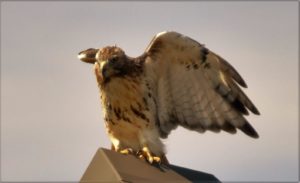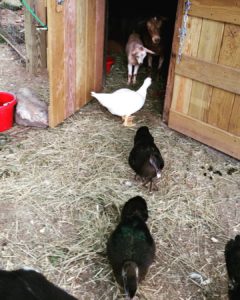After working on this article a few times, and gathering photos for it, an ironic thing happened the day I was going to post it. We had our first ever deadly predator attack. First. Ever.
After raising approximately 200-300 meat birds a year and providing a year-round, safe environment for about forty pet and breeding birds, a small hawk swooped into the Brahma chicken yard and killed a large hen twice its size. In her own fenced in yard. With two roosters unawares in the coop; the hawk killed her. After all the diligence I have paid over the years, and all the security measures we applied, she was gone. Just like that.

While I was on the other side of the yard, feeding the goats, letting the turkeys out for exercise, and collecting eggs from a different flock, the hawk was in the Brahma yard. I was out and about, and it didn’t fly away. The dog was with me, and it didn’t fly away. The Brahmas did not give an alert call. I had no idea what happened until I headed their way.

Penny was a dark Brahma hen. Nine months old. She just started laying two months prior. She and her entire flock are extremely quiet and docile. Even the roosters. Extremely shaken, I immediately put everyone on lockdown.
The next morning, we went over the predator plan that had been effective over the years. We added new techniques to the plan. Even though we already had overhead deterrents, we decided to add more to everyone’s’ yard.
That was when I noticed something unusual about the Brahma flock. I kept them inside while my guy draped their entire yard with neon fishing line and tied about 20 flashy mylar ribbons strips approximately 10 feet above the ground. It took the head rooster 15 minutes to look up and notice it, and that was only after a hen noticed it and started squawking.
This was extremely disturbing. Unlike the Brahmas, every other flock we have ever had were aware of their surroundings. Especially overhead. As soon as a silhouette soared above, they would hide, or let out an alert cry.
The experience of that hawk attack was a mixed bag of emotion: Anger, and sadness foremost. I debated whether I was even qualified to post this article, so I put it aside. After a little break to digest the incident, and applying additional predator proofing to the Brahma yard, I decided that yes, I was qualified. Maybe even more so now. I had been fortunate enough to experience zero predator losses for many years. Now I had the experience of a predator loss.
Predators want your poultry. They will dig under fences at night to get to them. They will hide outside-or soar above-watch them-wait for the right moment to attack. They can be very determined. You need to be more determined. Poultry are not predators. They are prey. Even roosters, toms, and drakes.
When is the best time to predator proof? Ideally, before you bring your feathered friends home. Otherwise, as soon as possible after. Waiting until something happens is the saddest time to do it.
What are the biggest predator threats to your poultry? It varies from state to state, climate to climate, and location. The most common predators in the United States are:
- Canines: Domesticated dogs, coyotes
- Felines: House cats, bobcats
- Marsupials: Opossum
- Reptiles: Snakes
- Various mammals; Skunk, raccoon, fox, rats
- Birds of prey: Hawks, owls
Prevention is the prime method to deal with predators. Make your property unfriendly to unwelcome guests. Do not leave food out. (pet food included). Play a radio outside when you’re inside for long periods or when you leave the property. When you see a hawk flying overhead -make noise! Many a poultry keeper has run around their yard waving a rake and yelling. Setting off a car alarm will scare larger predators (although it might scare your own animals in the process) but do whatever needed to keep predators OFF your property.
You cannot always know which predators will come nosing around your property, so how do you know how much predator proofing you need to do? In my opinion, there is never too much protection.
Predators can dig, jump, and fly. The methods you use should address these behaviors.
Night safety:
Everyone has their own method of animal husbandry. Some people do not coop up their birds at night and swear by guardian livestock dogs, outdoor lighting, or fencing. I will not dispute anyone’s’ tried and true method, but the safest and easiest way to protect birds at night is to put them into enclosed structures.
All coops, duck houses, turkey barns, etc.… need doors that latch closed, and need to be closed EVERY night.
Windows need to be actual windows that lock or covered with mesh. Screens can be torn through by sharp claws, so an extra barrier (mesh or wire) can make them safer.

Fencing:
Although an extra cost, fencing will be an invaluable investment. Not only does it keep your birds’ houses safer at night, but it also allows you to keep them in their own areas anytime. You are in control when they exit their yards. If you leave the property for periods of time, leaving them in their fenced-in runs/yards may be a safer option for them.
Birds of prey deterrents such as a fishing line with ribbons or netting can help with overhead attacks.
Wide gaps in fences need an extra barrier of wire or mesh. Skunks and raccoons can squeeze their hands through a chain-link fence and grab birds. Digging down a good 12 inches around the fence perimeter and running chicken wire down that far is a good way to discourage digging around poultry fences.
Be aware of any trees that you fence in. Birds other than your poultry can use them to perch on as well.
If you are trying to protect a short coop or duck house, placing it in the center of a fenced-in area will prevent a predator from hopping on top of it, and using it to get into their yard.
Electric netting, an electric wire along the top of a fence, or electric wire fencing is also an option. It all depends on if you have ground digging, climbing, or jumping predators.

Lights:
At night, you can leave lights on outside poultry houses, use motion-activated spotlights, or purchase those blinking red predator lights. There are mixed results in all of those, but it is known that most predators avoid brightly lit areas. Not always though. But if you do have some type of lighting, you’ll be able to see what’s going on if you hear a commotion.
Guardian Livestock Animals:
Guardian livestock dogs are great for protecting flocks, goats, and other animals. To be most effective, they need to be right where your animals live and sleep. If a dog is roaming the property at night, he could very well keep away predators. However, if the dog is on one side of the property, and an attack happens on the other side, you can easily lose birds before he can get there. If the predator does not run off, he then has the task of dealing with a predator head-on.
Donkeys, alpacas, goats, and llamas are often paired with poultry. The larger animals might keep predators at bay.

If an attack occurs:
If you examine a poultry crime scene, there are clues to what attacked your bird(s). Predators leave different clues, and sometimes no clue, which is a clue as well. After you examine the scene, take notes and pictures so you can research and determine what predator was involved.
Once you figure out what happened, you can take even further precautions to protect your remaining flock.
If a predator got into a coop, any holes need to be patched. If it is a door or lock situation-fix it. If the birds were not put in at night, they need to be put in from now on. If it was an overhead attack, netting or fishing line needs to be installed.
If it happens while your birds are free-ranging, it can be a daunting task to protect them. Most of us let our birds free-range even some of the time. There is no easy solution to a daytime predator attack. You just need to implement the best techniques available to keep your birds safe.
Even if we all have different types of poultry, live in deferent locations, and have different predators, I think most of us have the same goal: to allow our poultry to live their lives without being injured or killed by a predator.
Aside from poultry solitary confinement, all of us will experience a predator loss, but with the correct measures in place, we can lessen the number of predator attacks.












